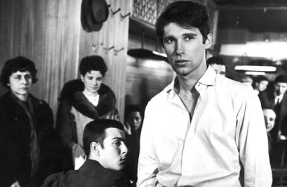
After previously playing a dog person for Kelly Reichardt in Wendy and Lucy (2008), Michelle Williams is now a cat person in Showing Up. Quietly intense in her wardrobe of shapeless earth tones, sullenly poking around Portland in crocs and socks, Williams’ Lizzy is finishing up a degree at the Oregon College of Art and Craft (OCAC), where she specializes in sculpture. Her rent-paying job in the school’s front office—under the watchful eye of the department supervisor (Maryann Plunkett), who happens to be her mother—enables her to share her two-floor, studio-basemented apartment with a pushy orange tabby whom Lizzy can barely seem to keep in Kibble.
From Robert Altman to Hal Ashby to the Coens, using a feckless feline as shorthand for a loner’s stubbornest traits is an old trick. Reichardt, however—who by now is no less than the aforementioned a Great American Filmmaker—makes the device work on her own, more naturalistic terms. Whether malingering by its perpetually empty bowl or jutting her claws out from underneath a closed basement door, Lizzy’s roommate exudes the coiled, ambient agitation of a creature bridling against its own domestication. When the animal mauls a pigeon that’s crept into the bathroom, it’s as if it were acting out some tetchy, subconscious impulse on its owner’s behalf.
The cat doesn’t finish the job. “Please go outside to die,” Lizzy urges the wounded intruder while sweeping it up and out the window. The next morning, though, she’s coerced into caring for the bird by her neighbour-slash-landlord-slash-classmate Jo (Hong Chau), another aesthete whose subtly overbearing Good Samaritan act—bandaging the victim’s wounds and nestling it into a cozy shoebox of its own—inspires what would seem to be a desired mix of resentment, shame, and competitiveness. Lizzy and Jo’s relationship, which we join in medias res and clearly extends beyond the purview of Christian Blauvelt’s fine-grained frames, is intimate but ambiguous: as ever, when it comes to questions of dramaturgy, Reichardt opts for a less-is-more approach. The same goes for her symbolism: in a lesser or more obvious movie,






